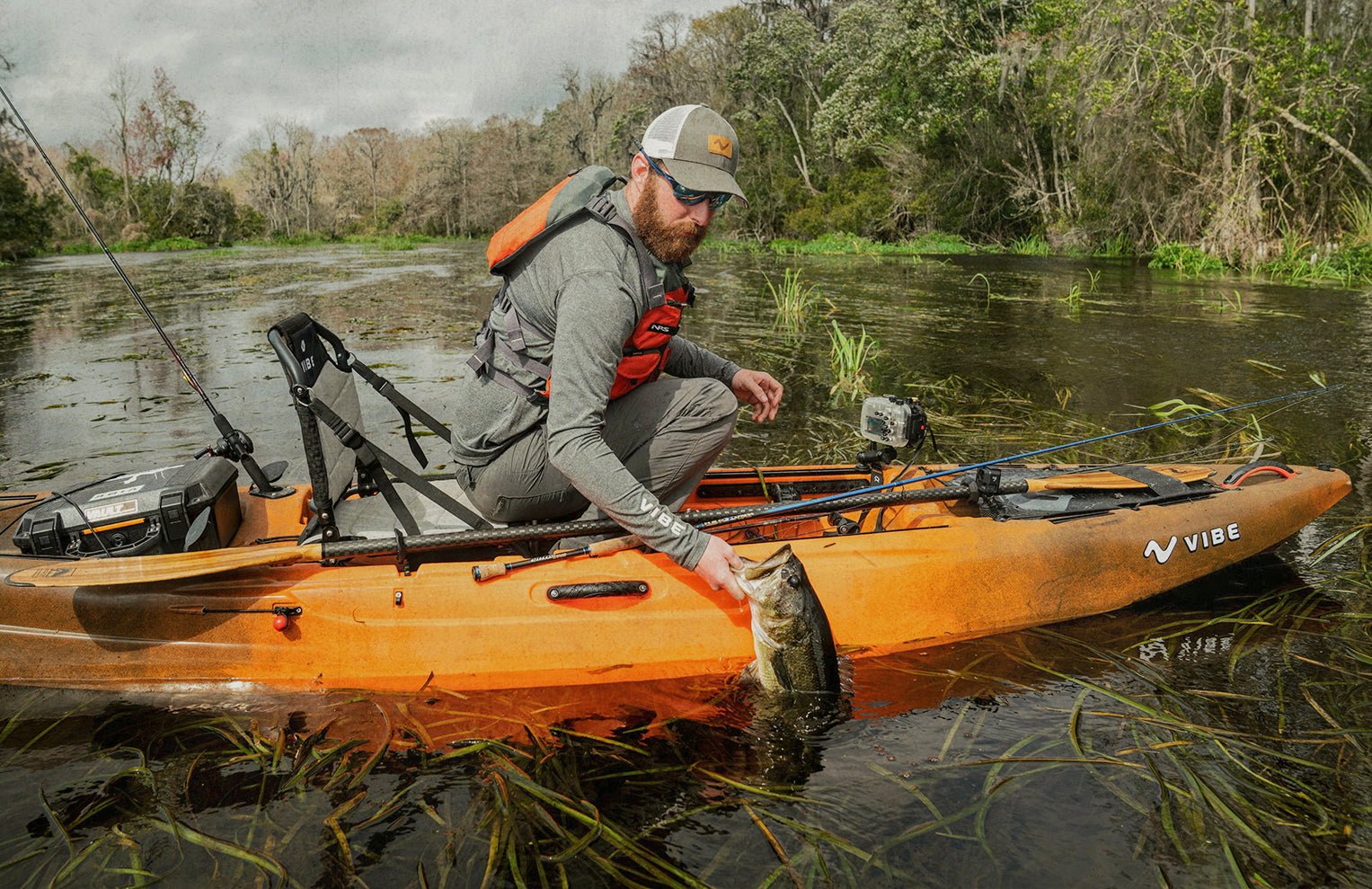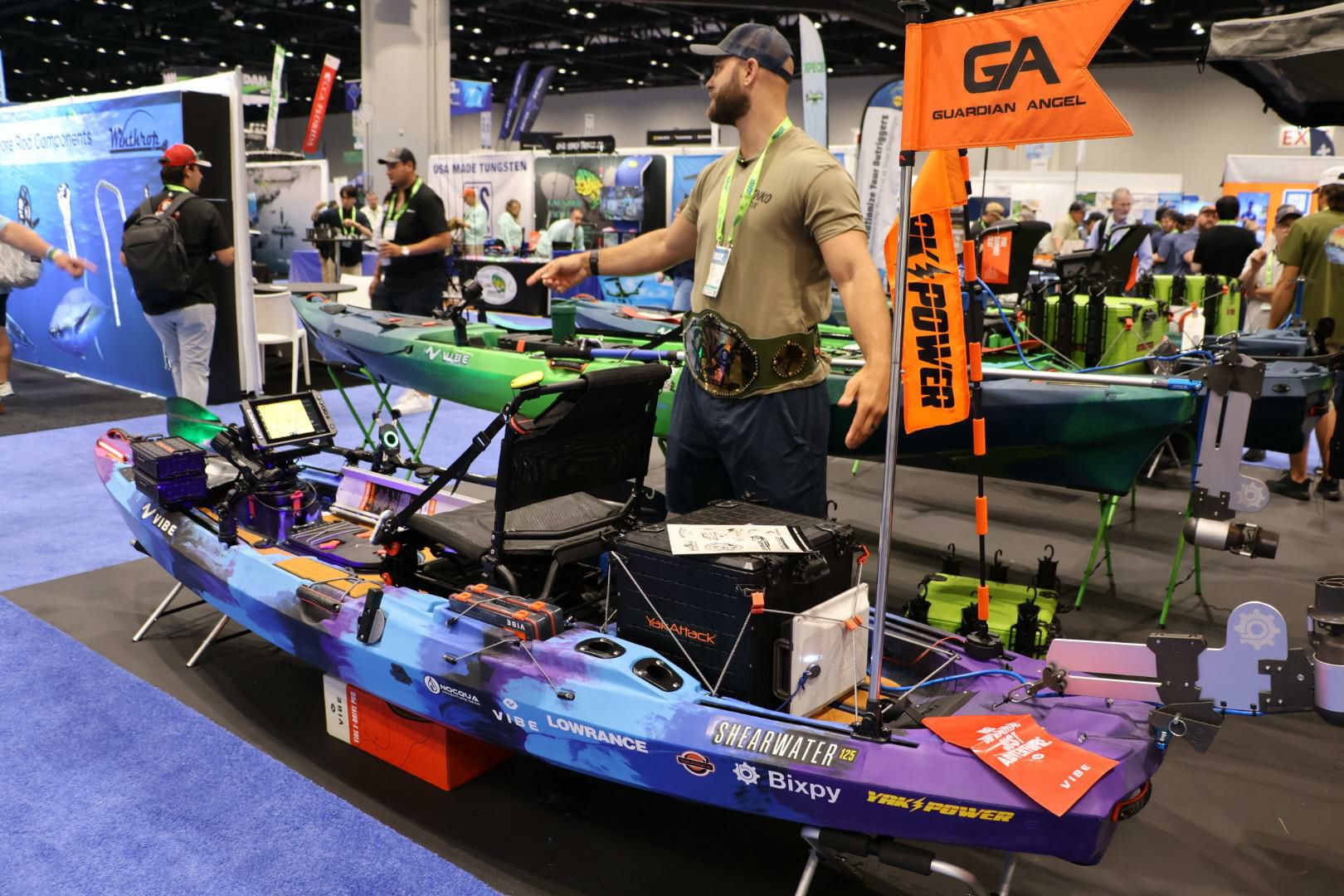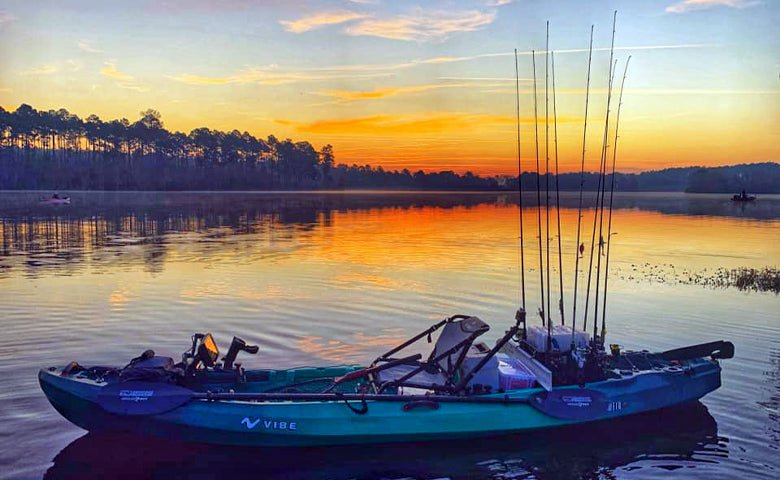Kayak Bass Fishing Gear Basics Checklist

This is the only 7am course you will want to take!
You’ll often hear the term “the tug is the drug” among kayak bass fishing enthusiasts. There is little that is as exciting or as addicting as seeing a big bucketmouth breaching out of the water on the other end of your line. But how do you get started in this great sport? This article will address the basics, the places to look for bass, a few basic techniques, and some generally good to know information. This is an introductory course, so if you are looking for more advanced tips tricks and techniques stay tuned, our future articles will cover those, as well as some fishing kayak DIY items, and general kayak angling tips and tricks!
Where can you find them?
Largemouth bass, like grass. Smallmouth bass like structure. Well, that was easy wasn’t it? General rules of thumb are just that, general. If you find weeds, and vegetation it is likely that you will find largemouth bass there as well given that you can present the correct presentation to them. It can be grass, lily pads, hydrilla, milfoil etc. Largemouth like to hang out in the grass and ambush their prey. Smallmouth bass tend to prefer boulders, logs, cervices and ledges, they employ similar ambush techniques so dropping the correct bait in front of them at the right time, should yield results. This is where kayak fishing is nice, you can get into those hard to reach spots to pinpoint those bass.
Once you find vegetation or structure, the rest is a matter of finding the correct presentation to entice that “tug”
Gear you will need:
Don’t let tournament bass anglers convince you that you need 25 different high-end rods reels and presentations to get started. They use all of those setups so they can quickly change tactics and try to pinpoint bass in a hurry. If you are just casually fishing for enjoyment, and/or you are just getting into the sport, it really makes more sense to slow down and learn what works for YOU. So grab yourself a Vibe fishing kayak and keep an eye out for these basic equipment must haves.
Rod/Reel:To get you started, a quality medium heavy spinning rod, and some mid-priced 10-15 lb test line will do you just fine. We will get more into technique specific equipment in future articles. For starting out though this pairing will do just fine.
Lures: Now we are getting somewhere, die hard bass people will tell you that the only sporting way to chase bass is with artificial lures. But where do you start when there are THOUSANDS of options? Remember that the classics are classics for a reason, they work. Pick up a spinnerbait, a crankbait or 3 (different colors, different running depths), pick up a topwater frog and dare I say the controversial NEW kid on the block the Whopper Plopper. That will set you up for success as far as hard baits go. For soft plastics, a versatile do everything bait such as a Gary Yamamoto Senko (or in our case, DIRIGO Bait Lunker Logs) can be rigged many ways and yield results. Another classic is a crawdad or “creature bait.” Pick whichever ones you like the look of, there are many, but their actions are typically pretty much the same, color will matter more than brand, try a few different colors, and narrow down your favorites as you progress.
Hooks/Weights: We are going to keep it REAL simple here for now. Grab some 3/0 straight shank and some #2 wacky worm hooks for the Senkos. Pick up some 4/0 extra wide gap hooks for the craws. As far as weights go, you can’t really go wrong picking up a variety pack of bullet weights.
Rigging:
Like most things bass fishing there are thousands of ways to present your bait to the fish. We are only going to focus on a handful of tried and true methods for convincing lunkers to bite.
Knots: We will keep things simple with the fisherman’s knot (Improved clinch knot) here. You can venture out and learn some of the dozens of great knots out there, but this is the one most people were taught as kids, and it is still used today because it is easy to tie, and holds up.

Texas Rig: The classic, ask any tournament angler, they will tell you that this rig works everywhere. This can be used with your worms, or your creature baits and craws. It’s easy to rig, but I will walk you through it in text and photos just so it sticks with you. Slide a weight onto your line and tie your hook on using a standard fisherman’s knot. Insert the barb into the nose of your worm, lizard, creature or craw and push it about a 1/2 inch into the bait, then exit the body. Slide the body over the eye of the hook, turn the hook 180 degrees, and re-insert the point.

Wacky Rig: This is a relatively new guy on the block, it is a very effective way to fish a Senko if you are patient the wacky rig WILL catch you fish. Another plus to the wacky rig is that it is dead simple to rig and fish. Use your #2 wacky hook, tie it on with a fisherman’s knot, and pierce the Senko the middle perpendicular to the worm. And there you go, it looks silly, but it will hook you up! For longer lasting worms, you can add an o-ring to middle of the worm, and run your hook under the ring instead of piercing the worm, this will just allow you to re-use worms after you catch because they will not get torn up as quickly. The tool used in the photo is called a Wacky Rig Tool and can be found at any tackle shop.

So now we know where to find bass, we have our gear, we have our fishing kayak, we know how to rig our soft plastics, we have some hard baits to play with, now what? Now we go fishing.
Techniques:
Some lures and baits are as simple as casting it out there and finding the best speed to retrieve it. Some require a little more user input to entice a bite.
Simple cast and retrieve lures and baits: Now just because they are cast and retrieve does not mean that we shouldn’t experiment with pausing, twitching, and retrieve speed. But for the most part baits such as your spinnerbait (can definitely benefit from varied retrieve speed and pauses to alter its running depth) crankbaits, whopper ploppers, chatterbaits, lipless cranks. Etc. are quite forgiving to retrieval technique. Toss them around cover (be it grass, weeds, or structure) fish them parallel to the bank and find the speed that works best for your area. For crankbaits you want them digging into the bottom or bouncing off structure. For spinnerbaits sometimes you will find its best to rip them fast near the top of the water column sometimes a slow roll with pauses works best.
User Input baits and lures: These include most soft plastics, jigs, frogs, jerk baits etc. For baits like the frog, make it look like a frog skipping across the top of the water, over lily pads, parallel with the bank, over and off stumps and structure, realism in the action is most important, twitch twitch twitch and reeling fast will give you the look you are going for. For baits like soft plastics, a slower presentation works best, slower more subtle twitches, letting the bait sink, moving it a few feet and letting it sink this stop and go retrieve coupled with a few twitches will get the bass’s attention. All these baits benefit from some variation of the “Twitch Twitch Pause” technique.
Keep it simple, don’t go throwing a crankbait with several hooks through a grass field where it is going to get fouled up every cast, but also don’t try fishing a topwater frog in 50 feet of water. Match your lure or bait to the forage you would expect to see in that location on the lake, frogs go in the thick vegetation. Worms can be found on the bottom of the lake, little fish bounce off rocks and roots with no abandon so throw your crankbait to imitate them, crayfish like to burrow into the bottom, under large rocks, and at the edges of weed beds, fish those there (smallmouth LOVE them). Casting many baits in 5-12 feet of water and pulling it parallel to the bank will increase your strike zone by allowing the bait to stay in the depth range that a bass would be hanging out. A lot of learning to get better at this is experimenting with these techniques and learning what works for you as an individual, and in your particular body of water.
You will quickly learn what is working for you and from there you can branch into new and different techniques, before you know it you will be kayak fishing in a new Vibe Shearwater fishing kayak with 12 rods on it, and 8 big tackle trays in your crate, wired up for sonar/gps, and entering bass tournaments. We did warn you before we started that “The tug is the drug” after all, this sport can be very addicting!
Tune in to Bass Fishing 202, Rods Reels and Line for a deeper dive into the world of bass fishing gear!
See you on the water!



